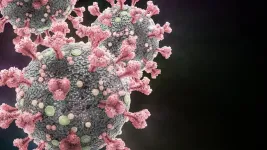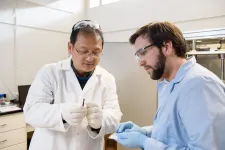A new super-Earth detected orbiting a red dwarf star
2021-04-16
(Press-News.org) In recent years there has been an exhaustive study of red dwarf stars to find exoplanets in orbit around them. These stars have effective surface temperatures between 2400 and 3700 K (over 2000 degrees cooler than the Sun), and masses between 0.08 and 0.45 solar masses. In this context, a team of researchers led by Borja Toledo Padrón, a Severo Ochoa-La Caixa doctoral student at the Instituto de Astrofísica de Canarias (IAC), specializing in the search for planets around this type of stars, has discovered a super-Earth orbiting the star GJ 740, a red dwarf star situated some 36 light years from the Earth.
The planet orbits its star with a period of 2.4 days and its mass is around 3 times the mass of the Earth. Because the star is so close to the Sun, and the planet so close to the star, this new super-Earth could be the object of future researches with very large diameter telescopes towards the end of this decade. The results of the study were recently published in the journal Astronomy & Astrophysics.
"This is the planet with the second shortest orbital period around this type of star. The mass and the period suggest a rocky planet, with a radius of around 1.4 Earth radii, which could be confirmed in future observations with the TESS satellite", explains Borja Toledo Padrón, the first author of the article. The data also indicate the presence of a second planet with an orbital period of 9 years, and a mass comparable to that of Saturn (close to 100 Earth masses), although its radial velocity signal could be due to the magnetic cycle of the star (similar to that of the Sun), so that more data are needed to confirm that the signal is really due to a planet.
The Kepler mission, recognised at one of the most successful in detecting exoplanets using the transit method (which is the search for small variations in the brightness of a star caused by the transit between it and ourselves of planets orbiting around it), has discovered a total of 156 new planets around cool stars. From its data it has been estimated that this type of stars harbours an average of 2.5 planets with orbital periods of less than 200 days. "The search for new exoplanets around cool stars is driven by the smaller difference between the planet's mass and the star's mass compared with stars in warmer spectral classes (which facilitates the detection of the planets' signals), as well as the large number of this type of stars in our Galaxy", comments Borja Toledo Padrón.
Cool stars are also an ideal target for the search for planets via the radial velocity method. This method is based on the detection of small variations in the velocity of a star due to the gravitational attraction of a planet in orbit around it, using spectroscopic observations. Since the discovery in 1998 of the first radial velocity signal of an exoplanet around a cool star, until now, a total of 116 exoplanets has been discovered around this class of stars using the radial velocity method. "The main difficulty of this method is related to the intense magnetic activity of this type of stars, which can produce spectroscopic signals very similar to those due to an exoplanet", says Jonay I. González Hernández, an IAC researcher who is a co-author of this article.
INFORMATION:
The study is part of the project HADES (HArps-n red Dwarf Exoplanet Survey), in which the IAC is collaborating with the Institut de Ciències de l'Espai (IEEC-CSIC) of Catalonia, and the Italian programme GAPS (Global Architecture of Planetary Systems), whose objective is the detection and characterization of exoplanets round cool stars, in which are being used HARPS-N, on the Telescopio Nazionale Galileo (TNG) at the Roque de los Muchachos Observatory (Garafía, La Palma). This detection was possible due to a six year observing campaign with HARPS-N, complemented with measurements with the CARMENES spectrograph on the 3.5m telescope at the Calar Alto Observatory (Almería) and HARPS, on the 3.6m telescope at the La Silla Observatory (Chile), as well as photometric support from the ASAP and EXORAP surveys. Also participating in this work are IAC researchers Alejandro Suárez Mascareño, and Rafael Rebolo.
Article: B. Toledo-Padrón, A. Suárez Mascareño, J. I. González Hernández, R. Rebolo, et al. "A super-Earth on a close-in orbit around the M1V star GJ 740". Astronomy & Astrophysics, April 7th, 2021. DOI: 10.1051/0004-6361/202040099
[Attachments] See images for this press release:

ELSE PRESS RELEASES FROM THIS DATE:
2021-04-16
One of the most comprehensive statistical analyses of drivers of food insecurity across 65 countries has concluded that household income consistently explains more discrepancy in food security than any other factor, including agricultural land resources and production. The Thayer School of Engineering at Dartmouth study, "Cross-national analysis of food security drivers: comparing results based on the Food Insecurity Experience Scale and Global Food Security Index," was recently published by the peer-reviewed journal Food Security.
Given the persistent issue of food insecurity--one of the United Nation's sustainable development goals is to achieve zero hunger--the study's results are vital in determining how best to tackle the complex problem.
"We're ...
2021-04-16
Boulder, Colo., USA: Volcanologists' ability to estimate eruption risks is largely reliant on knowing where pools of magma are stored, deep in the Earth's crust. But what happens if the magma can't be spotted?
Shane Rooyakkers, a postdoctoral scholar at GNS Science in New Zealand, grew up in the shadow of Mount Taranaki on the country's North Island, hiking on the island's many volcanoes. Today, his research is revealing hidden dangers that may have been beneath his feet all along.
A new study, published yesterday in Geology, explores a threat volcanologists discovered only recently: surprisingly shallow magma pools that are too small to be detected with common volcano monitoring equipment. Such a magma body was ...
2021-04-16
LA JOLLA, CALIF. - April 16, 2021 - Scientists at Sanford Burnham Prebys have identified a set of human genes that fight SARS-CoV-2 infection, the virus that causes COVID-19. Knowing which genes help control viral infection can greatly assist researchers' understanding of factors that affect disease severity and also suggest possible therapeutic options. The genes in question are related to interferons, the body's frontline virus fighters.
The study was published in the journal Molecular Cell.
"We wanted to gain a better understanding of the cellular response to SARS-CoV-2, including what drives a strong or weak response to infection," says Sumit K. Chanda, Ph.D., professor and director of the Immunity and Pathogenesis Program at Sanford Burnham Prebys and lead ...
2021-04-16
Scientists have figured out how to modify CRISPR's basic architecture to extend its reach beyond the genome and into what's known as the epigenome -- proteins and small molecules that latch onto DNA and control when and where genes are switched on or off.
In a paper published April 9, 2021, in the journal Cell, researchers at UC San Francisco and the Whitehead Institute describe a novel CRISPR-based tool called "CRISPRoff," which allows scientists to switch off almost any gene in human cells without making a single edit to the genetic code. The researchers also show that once a gene is switched off, it remains inert in the cell's descendants for hundreds of generations, unless ...
2021-04-16
Look deep inside the brain of someone with Alzheimer's disease, most forms of dementia or the concussion-related syndrome known as chronic traumatic encephalopathy (CTE) and you'll find a common suspected culprit: stringy, hairball-like tangles of a protein called tau.
Such conditions, collectively known as "tauopathies" strike scores of people across the globe, with Alzheimer's alone affecting six million people in the United States.
But more than a century after German psychiatrist Alois Alzheimer discovered tau tangles, scientists still have much to ...
2021-04-16
What The Study Did: The fitted filtration efficiency of commonly available masks worn singly, doubled or in combinations was evaluated in this study.
Authors: Emily E. Sickbert-Bennett, Ph.D., M.S., of the UNC Medical Center in Chapel Hill, North Carolina, is the corresponding author.
To access the embargoed study: Visit our For The Media website at this link https://media.jamanetwork.com/
(doi:10.1001/jamainternmed.2021.2033)
Editor's Note: The article includes conflict of interest and funding/support disclosures. Please see the article for additional information, including other authors, author contributions and affiliations, conflict of ...
2021-04-16
CHAPEL HILL, NC - A study published today in JAMA Internal Medicine shows that wearing two face coverings can nearly double the effectiveness of filtering out SARS-CoV-2-sized particles, preventing them from reaching the wearer's nose and mouth and causing COVID-19. The reason for the enhanced filtration isn't so much adding layers of cloth, but eliminating any gaps or poor-fitting areas of a mask.
"The medical procedure masks are designed to have very good filtration potential based on their material, but the way they fit our faces isn't perfect," said Emily ...
2021-04-16
Thermoelectrics directly convert heat into electricity and power a wide array of items -- from NASA's Perseverance rover currently exploring Mars to travel coolers that chill beverages.
A Clemson University physicist has joined forces with collaborators from China and Denmark to create a new and potentially paradigm-shifting high-performance thermoelectric compound.
A material's atomic structure, which is how atoms arrange themselves in space and time, determines its properties. Typically, solids are crystalline or amorphous. In crystals, atoms are in an orderly and symmetrical pattern. Amorphous materials have randomly distributed atoms.
Clemson researcher Jian He and the international team created a new hybrid compound in which the crystalline and ...
2021-04-16
Russian scientists have proposed a theory of phase transformation in polymer gels. It explains the mechanisms of the dramatic reduction in volume of zwitterionic hydrogels when they are cooled. The results are published in the journal Chemical Communications (ChemComm).
Polymer gels have unusual properties, including the ability to absorb water in volumes hundreds of times greater than their own. For example, some hydrogels are capable of holding up to two kilograms of water per gram of dry gel. By changing the temperature or adding solvents, various desired properties can be achieved. This is why polymer gels are used in industry and biomedicine, including for the targeted delivery of medication, creation of artificial skin, children's toys, etc.
If you take ...
2021-04-16
Two new studies published in Blood suggest that the mRNA COVID-19 vaccine may have reduced efficacy in individuals with chronic lymphocytic leukemia (CLL) and multiple myeloma, two types of blood cancer. According to researchers, these studies could help inform the ideal time for vaccination of these populations.
Study suggests two-dose COVID-19 vaccine is less effective for people with CLL as compared to healthy controls
The first study reports that people with CLL had markedly lower immune response rates to the two-dose mRNA COVID-19 vaccine than healthy individuals ...
LAST 30 PRESS RELEASES:
[Press-News.org] A new super-Earth detected orbiting a red dwarf star




